Review of the “Rucheek” water pump: device, connection and operation rules
Vibrating pump units will perform a colossal amount of hard, often “dirty” work for summer residents and owners of private houses. The compact water pump “Rucheek” will pump water from an open or underground source, “transfer” it from the storage tank to the irrigation points, and help clean the bottom of the well.
Agree, such a wide range of work can be done by few devices. Despite the popularity and long-term practice of operating “Rucheyok”, few are familiar with its design features. Not everyone understands in what situations this device is simply irreplaceable, or how to properly connect and use it.
We are happy to share complete information about the listed points of interest to you. Here you will find a detailed overview of the characteristics and technical capabilities of the device. The information provided in the article is supplemented by photo collections and video tutorials.
The content of the article:
Operating principle and device
The “Rucheek” pump is one of the most popular vibration-type pumps. The central part of the design of this unit is the membrane. When the pump is turned on, it is attracted and repelled under the influence of an electromagnetic coil built into the pump.
The oscillatory movements of the membrane create a pressure difference in the pump casing, which allows water to be moved to a sufficiently large height.
“Stream” is submersible pump, that is, to operate it must be lowered on a cable into the water. The device is relatively small, weighing only 4 kg.The performance of the standard model is usually rated at 450 l/h.
Technically, the pump is designed to pump clean water, so the product warranty does not cover damage caused by operation in difficult conditions.
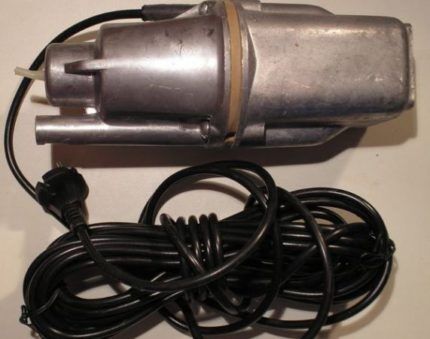
A special rubber ring is installed across the durable metal pump body. It protects the well casing from impacts during immersion or removal of the device.
To hang the pump, you can use a nylon cord or fairly strong twine, since the weight of the unit is light. Of course, the cable should be securely fastened to the string so that it does not fall into the well.
Modern models of the “Rucheek” pump are equipped with a special sensor. It detects the temperature of the device and turns off the device when it reaches critical values. Most often, such situations arise if for some reason the pump is out of the water column.
Protection against so-called “dry running” prevents equipment breakdowns and extends its service life.
Technical parameters of the “Rucheek” pump:
- pumped water temperature — no more than 35°С;
- power - 150-270 W, so its operation will not increase overall energy costs too much;
- immersion depth — within 40-60 m;
- average performance - about 7 l/min.
It should be remembered that the deeper the pump is suspended, the lower its performance. If the pump is submerged just one meter or less, it can pump water at a rate of 1500 l/h.
The performance of the unit is quite modest. Residents of the house will have to turn on the water intake points in turn: first wash the dishes, then take a shower, then turn on the washing machine. The productivity of “Rucheyok” may not be enough for all needs at once.
“The Stream is not intended for working with sea water.
Connection and operating rules
Before, how to install the pump “Rucheek” in well or well, a number of preparatory measures should be performed. First, determine exactly at what depth the pump will be suspended. You should stock up on a cord or rope of suitable length and provide a place for fixing the cable while the pump is operating.
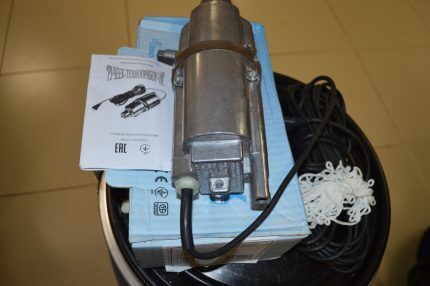
The cord must be strong enough to support up to five times the weight of the suspended equipment. In the case of “Rucheyok” we are talking about twenty kilograms.
This point should not be neglected, because a pump falling into a well can become a real disaster.And getting broken equipment out of a well is not the greatest pleasure.
It is not recommended to suspend vibration equipment on a metal cable, since such structures are poorly compatible with the vibration impact that occurs during operation of the unit.
To partially dampen vibration, the pump is attached to a cord on a suspension made of durable and elastic rubber, a piece of which must also be stocked up in advance.

Another necessary element is a hose through which water will flow upward. Its length must correspond to the immersion depth of the pump, and the diameter of the hose must match the pump nozzle.
However, there are adapters that allow you to attach a hose of a larger or smaller diameter to the pipe. The end of the hose on the pipe or adapter should be secured with a clamp, unless other methods of fastening are provided.
If the use of a hose is for some reason undesirable or inconvenient, you can use a flexible plastic water pipe. It also needs to be securely secured to the pipe using a clamp. If all materials are prepared and the nuances are taken into account, you can begin installing the pump.
To do this you need to follow a number of simple steps:
- Unpack the “Rucheek” pump, straighten the electrical cable.
- Attach a nylon cord with a rubber adapter to the eye on its body.
- Attach a hose or water supply pipe to the pump outlet.
- Place a special protective filter on the water intake hole.
- Carefully and smoothly lower the pump into the well or well.
- Secure the nylon cord.
- Connect the pump to the power supply.
- Press the power button and check the operation of the device.
When purchasing a “Rucheek” pump, you should immediately check the length of the electrical cable that comes with the product. The standard model can be equipped with a cable length of 10, 15, 25 or 40 m, this is reflected in the cost of the device.
If the wire is not long enough, the problem can be solved in one of two ways.
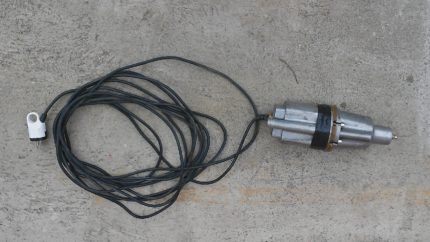
The first is to completely replace the pump cable with a new wire of the appropriate length. To perform this operation, the pump will have to be disassembled and then reassembled. Sometimes it’s easier to extend the cable - attach a fairly long piece to an existing wire.
The junction of the cables should be carefully insulated and protected with a special heat-shrink sleeve. Complete cable replacement is more reliable because the part of the wire immersed in water remains intact.
But cable extension is a less labor-intensive procedure. After the pump is lowered into the water, you should inspect the resulting system and make sure that the load falls on the nylon cord and not on the cable or hose.
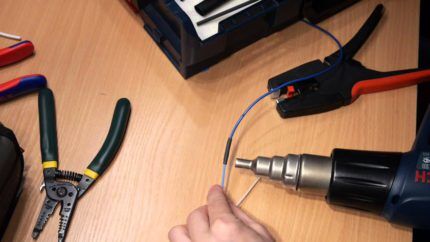
Both the cable and the hose should hang freely, remaining in a relaxed state.However, the cable should not be allowed to sag excessively, since during the process of lowering and raising the pump it may become tangled, and this will create additional problems.
Proper use of the pump allows you to increase its service life and trouble-free operation. The manufacturer indicates the continuous operation time of the pump is no more than 12 hours.
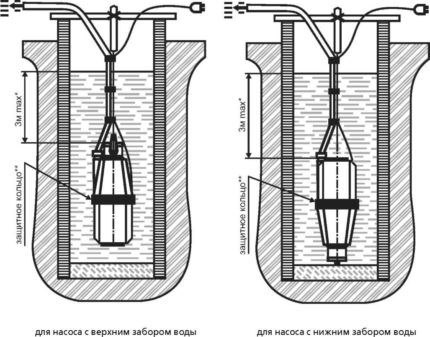
After this, the device should be turned off to cool down. Manufacturers also recommend taking short breaks every two hours of operation of the device. Such a gentle operating mode will have a positive effect on the service life of the device.
When hanging the device, remember that it should be located approximately 0.5-1 meter from the sandy bottom, otherwise it may simply be pulled into the sand or layer of silt.
Main advantages and disadvantages
The popularity of the “Rucheek” submersible pump can be explained simply: at a relatively low price, this device is of fairly high quality. But this is not his only advantage. “Rucheek” is extremely easy to use. It needs to be specially configured in some way; just press the power button and it will start working.
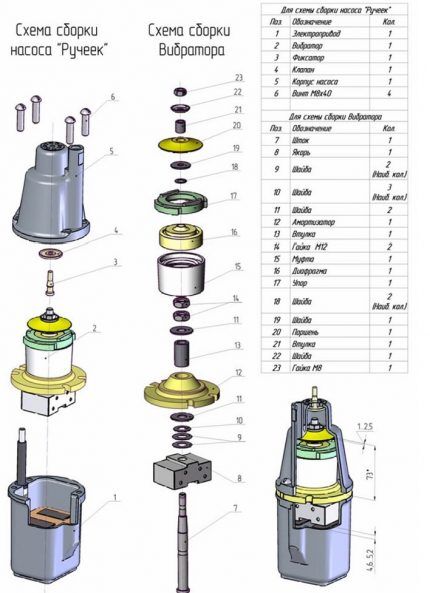
The simple design of the pump ensures its exceptional maintainability. When pump breakdown It is not difficult to disassemble, repair or replace damaged components, and then reassemble. All components necessary for repair are usually available for free sale.
The next “plus” of this pump is the wide range of tasks that can be solved with its help. The “stream” pumps not only clean water, but also some contaminated liquids, although this shortens its service life.
The disadvantages of the “Rucheek” pump include the nature of its operation. Continuous vibration exposure can negatively affect the condition of the filter well. Vibrations destroy the sand layer, which increases the rate of sanding of the well and can completely disable the structure.
A deep well extracting water from fractured limestone is not afraid of vibration, but “Rucheyok” is not designed to digest water from such a great depth. Therefore, pumps of this type are not suitable for continuous operation in sand wells. However for drawing water from a well such equipment can be a real godsend.
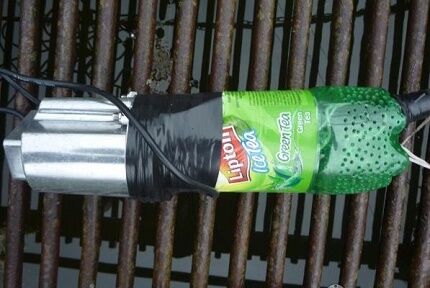
“Rucheek” for all occasions
It is best to equip a relatively shallow well with a low flow rate or a well with similar characteristics with a “Rucheek” pump or another budget model. More powerful and expensive equipment is simply not needed here. It will empty the well too quickly; the danger of a “dry run” in such a situation is very high.
The product data sheet says that the pump is intended only for digesting clean water. However, over the decades of the model’s existence, owners of private houses and summer cottages have found a wide variety of uses for this device. For example, this model is widely used in well pumping.
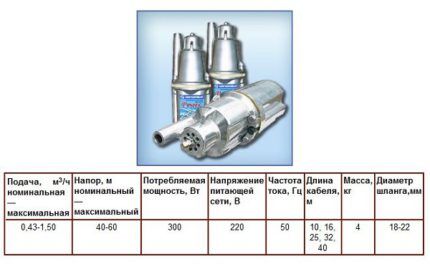
After drilling of such structures is completed, the water remains heavily contaminated with particles of silt, sand, etc. To obtain potable clean water, this mixture must be completed.
Practice has shown that “Rucheek” copes well with this task. The peculiarity of the Brooklet pump is that it has no rotating parts. Therefore, it does not clog too quickly when working in contaminated water.
Periodically, the pump is removed, disassembled, washed, the necessary repairs are made, and then reassembled and put into operation. Of course, with such treatment, the wear rate increases significantly. It is not surprising that during the process of pumping a well, the pump can completely fail.
To clean one well, depending on the situation, you may need two or even three or four such units. But in terms of money it comes out much cheaper than purchasing special equipment with increased wear resistance.
Inexperienced property owners sometimes believe that they can pump the well using the pump that will supply water to the water supply of the house. This is absolutely the wrong decision.
Owners of wells and wells periodically have to clean out your buildings. In these cases, a pump of this type is irreplaceable. It will effectively cope with pumping contaminated water from a well or borehole.
If the pump is at hand, all work will be completed much faster. If the well is silted or sandy, the vibrations that arise during the operation of the Brook turn from an enemy into a friend.
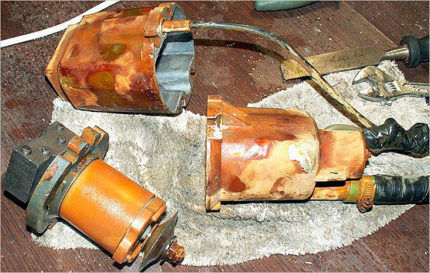
High quality and expensive submersible pumps usually designed for long-term operation with clean water. It is better to pump water heavily contaminated with sand using a “Rucheyok” or other budget equipment. If, after pumping the well, some “Stream” managed to “survive”, it will definitely find further use.
The vibrating effect allows you to quickly and effectively destroy the silt plug, clean the holes in the well filter and pump out dirt to the surface. As a result, the well's flow rate will increase significantly.
To clean silted wells, it is recommended to use a model with an upper water intake.
“Stream” gathering dust in the barn will become a real find if the main pump in a well or well breaks down for some reason. It will be a completely acceptable temporary replacement, allowing you to restore water supply in the house in a matter of hours.While the main pump is being repaired, you will not have to purchase or rent new equipment.
Flooding of a basement, inspection hole in a garage, or other similar recess with drainage water is an unpleasant situation. And scooping out unnecessary liquid with a bucket will take a lot of time and effort.
Since drainage water usually does not contain much contaminants, the “Rucheek” pump is ideal for pumping it out.
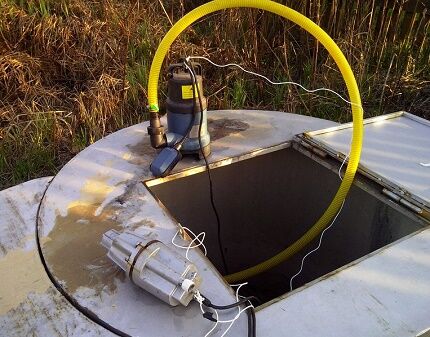
It works slowly, of course, but steadily. Of course, one cannot expect ideal purity from drainage water. To improve the operation of the pump, it is recommended to use a special additional filter that will protect the structure from contamination.
The filter is made in the form of a cap and is intended for the upper part of the pump. To put it on, it is recommended to warm up this element first. Then installing the filter will be much faster and easier.
If your house has a swimming pool or other large reservoir of water, the “Rucheek” pump can be used to pump water out of such containers. In this case it makes sense to use the model “Rucheek-1M”. Unlike other models, it is equipped with a lower water intake, which allows you to completely remove water from the tank.
Pumps of the “Rucheek” type are also used when installing heating systems, namely for pressure testing, when filling the system with water is required. Water can be taken from a well or brought in a separate barrel.
Place a hose on the pump inlet and lower it into the water.The second hose, put on the pump supply pipe, is connected to the open drain valve of the heating system.
Using a pressure gauge, the pressure in the system is monitored. After crimping, the identified faults are eliminated. In general, we can say that “Rucheek” type pumps can be used to solve almost any problem of pumping out liquid or pumping it to its destination. The main requirement is that the water should not be too dirty.
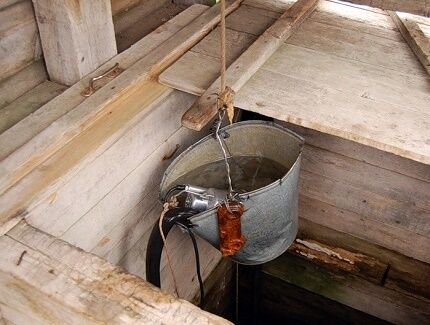
Modifications and similar models
There are three models of such a pump on the market: “Stream” (manufactured by JSC Livgidromash, Russia), “Rucheek-1” And “Rucheek-1M” (produced by Tekhnopribor OJSC, Belarus).
They are very similar in design, but there are some differences. Thus, the “Rucheek-1” model is equipped with an upper water intake system, which allows you to obtain the cleanest drinking water possible.
But “Rucheyok-1M” has a hole for water intake located at the bottom. Using this model, it is more convenient to pump water from tanks that need to be completely emptied. Since in the “Rucheek” and “Rucheek-1” models water is drawn from above, the design itself serves as reliable protection against overheating.
The water entering the pump housing simultaneously cools the engine. During testing, it was confirmed that devices of this type can withstand dry running for seven hours. In this case, the electric motor windings do not burn out.
Not all pumps, even the more expensive and efficient ones, can boast this level of stability.When the pump operates for a long time without water, in many other models the electric motor simply burns out.
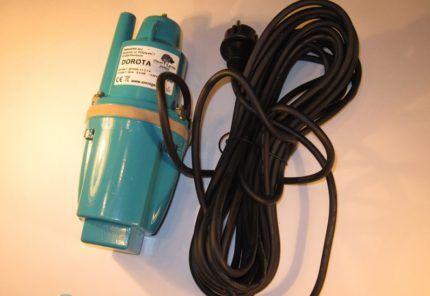
Among pumping equipment similar to “Rucheyok”, one cannot help but recall the pump "Baby". It is very close to “Rucheyok” in terms of technical characteristics, workmanship, and maintainability.
This equipment is produced by the Bavlensky Electric Motor plant, as well as by AEK Dynamo (Moscow). Some indicators of “Malysh” are slightly better, but the price is also slightly higher than that of “Rucheyok”
Among lesser-known analogues it is worth mentioning UNIPUMP BAVLENETS - a Russian brand that is produced in China. A study of the technical characteristics of the unit shows that it is not much different from the more famous “Rucheyok”.
The price characteristics of these pumps are also almost the same. The cost for the same pump may vary depending on the length of the cable.
An interesting alternative could be Omnigena-Dorota — submersible vibration pump made in Poland. The principle of its operation and device are not much different from the “Rucheek” pump. The only difference is that the aluminum body is a little shorter and the pump weighs a little less.
The power of the model is 300 W, and it can be submerged to 50 m. Reviews about the quality of the Polish pump are quite satisfactory.
Conclusions and useful video on the topic
Here you can see a practical example of how a pump of this brand works:
The video clip shows a diagram of the pump design, its technical parameters, and also indicates the features of using the “Rucheyok”:
The “Rucheek” pump is a tireless worker and a faithful assistant for all owners of dachas and private plots.
Of course, its performance is not very high, and it is not designed to solve global cleaning tasks. But where you need to pump water or clean a well, “Rucheek” can be the best option.
Do you have experience working with the Rucheek submersible pump? Tell us for what purposes you use the unit, share your impressions of using the equipment with our readers. You can ask questions and leave comments on the article in the form below.




A worthy heir to Soviet industry. I also noticed that many people use it. If you compare inexpensive offers, these are better; the “Chinese” ones burn out in a year or two. There is a trick to extend the life of the pump - you can make something like a hard mesh cap near the water intake hole. But not close. Then, even if the rope “looses,” it will silt less and small pebbles will be sifted out. Well, it’s better not to pair the cord. It's not that difficult to change to a new one.
I received the Rucheek pump along with the purchased dacha from the previous owner. It worked for one season without any complaints, but in the second year the jet at first became noticeably thinner. The work began to be accompanied by a louder hum, and then it completely stopped pumping water. I started looking at what to replace it with, went around choosing it, but in the end I just took the same Brook. It costs just a penny, but it works fine.
I have already replaced several pumps. They work reliably, but for some reason the body is heavily oxidized to the point of holes. I covered up the holes with “cold welding,” but they appeared again in other places.How to protect yourself from oxidation? Water is drawn from a well.
You have problems with water in your well. It is alkaline, the aluminum alloy body reacts with your well water.
Ground the pump body by throwing another wire on top of the wire to the pump body, and stick it into the ground at the top.
We bought a trickle of technopribor 1M, it worked for 3 months. Stopped turning on - what's the reason?
Hello. I'm guessing it's broken for you :) Seriously, more details are needed. For example, were there any other problems during operation, how did it break down - during operation or after a period of rest, did it hum suspiciously, what kind of water do you have. In an amicable way, it is necessary to disassemble and diagnose the internals.
After purchase, it is better to immediately disassemble both “Rucheyok” and “Malysh” and check for the absence of unnecessary parts inside the pump - washers, screws, etc. Before disassembling, make marks on the body so that you can then reassemble the body in the same position. Replace the valve mount and the main coupling bolts with nuts (4 pcs) with ones made of stainless material; you will have to stock up on these parts in advance, since they are not commercially available. Before assembly, carefully check the tightness of the membrane (diaphragm) nut on the rod, ensure that it is securely fastened to prevent self-loosening. This is almost 30 years of experience using these pumps. In general, they are good; how to eliminate the shortcomings is described above. It is more difficult with winding burnout; it is impossible to prevent it if you handle the pump wisely; repair is impractical; it is easier to buy a new pump. So regarding burnout - as God willing.Maybe it will last 5-6 years, or maybe it won’t last even one summer. Anything can happen...
By the way, if over time the pump began to buzz louder and the water pressure weakened, this is a sure sign that either the valve mount or the diaphragm mount inside has become loose. I would like to take it apart and repair it now, but... try unscrewing the coupling bolts! It doesn’t take much time for ordinary steel immersed in water to set up with rust so that it will be very difficult to unscrew the bolts, in addition, their location is such that you can’t really grab it. All that remains is to chop, saw, drill - you understand... that’s why it’s better to replace these bolts immediately, while they are still new, with ones made of stainless steel or brass.
There is no point in grounding a pump immersed in water; it is already grounded better than ever. Holes in the body are more likely a defect in factory casting, in which voids remain in the thickness of the metal, which later emerge in the form of holes. This often occurs with any metals, whether non-ferrous or ferrous, and can be found in stainless steel as well.
Allegedly, I forgot to unplug the pump cord for the stream with the upper water intake and it worked for a whole week, pumping water from the neighbor’s well, until I cut the power cord. Is this possible?!
Hello! Can a stream pump with an upper intake work for 8 days without interruption, pumping water from a village well?